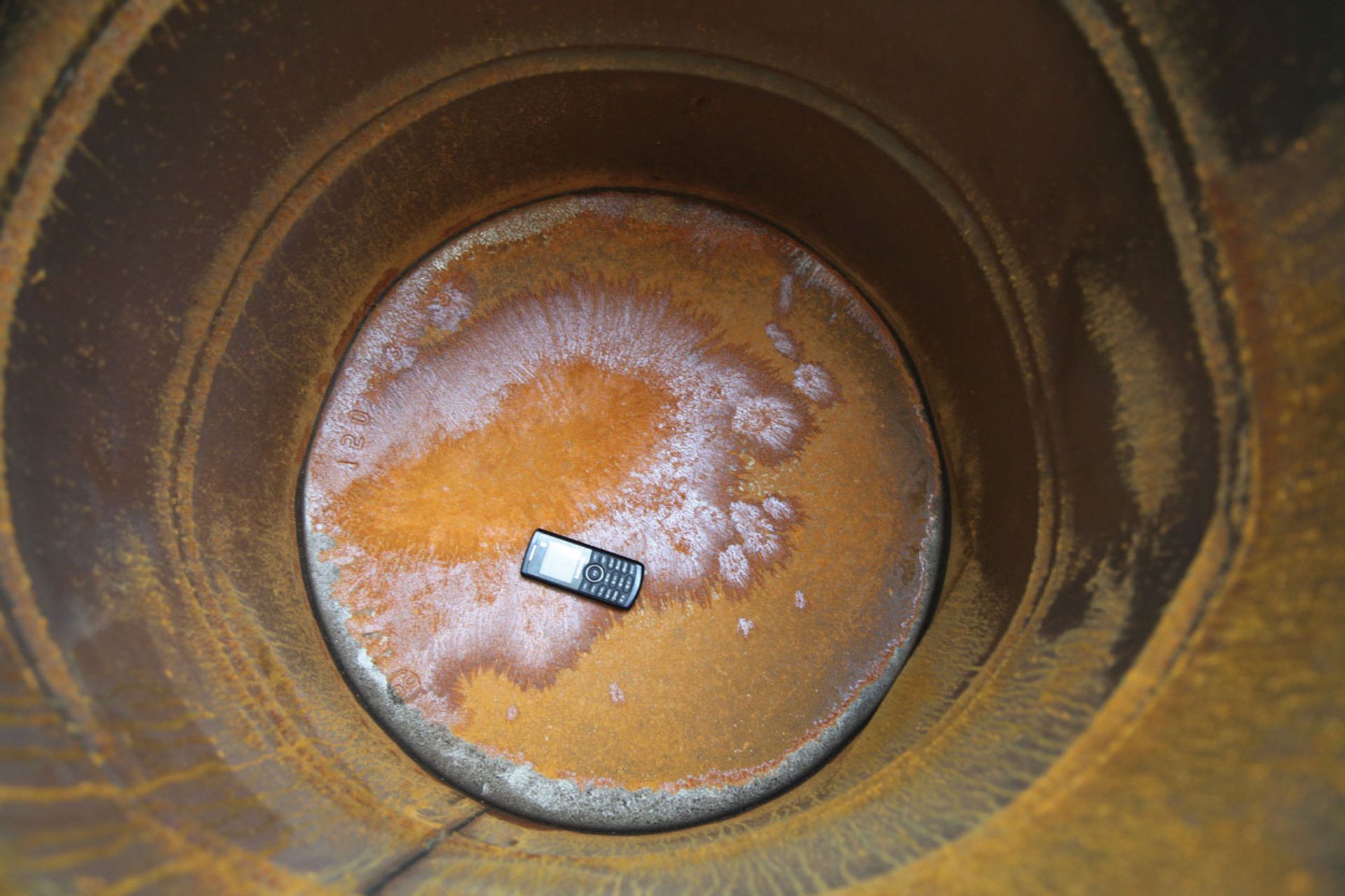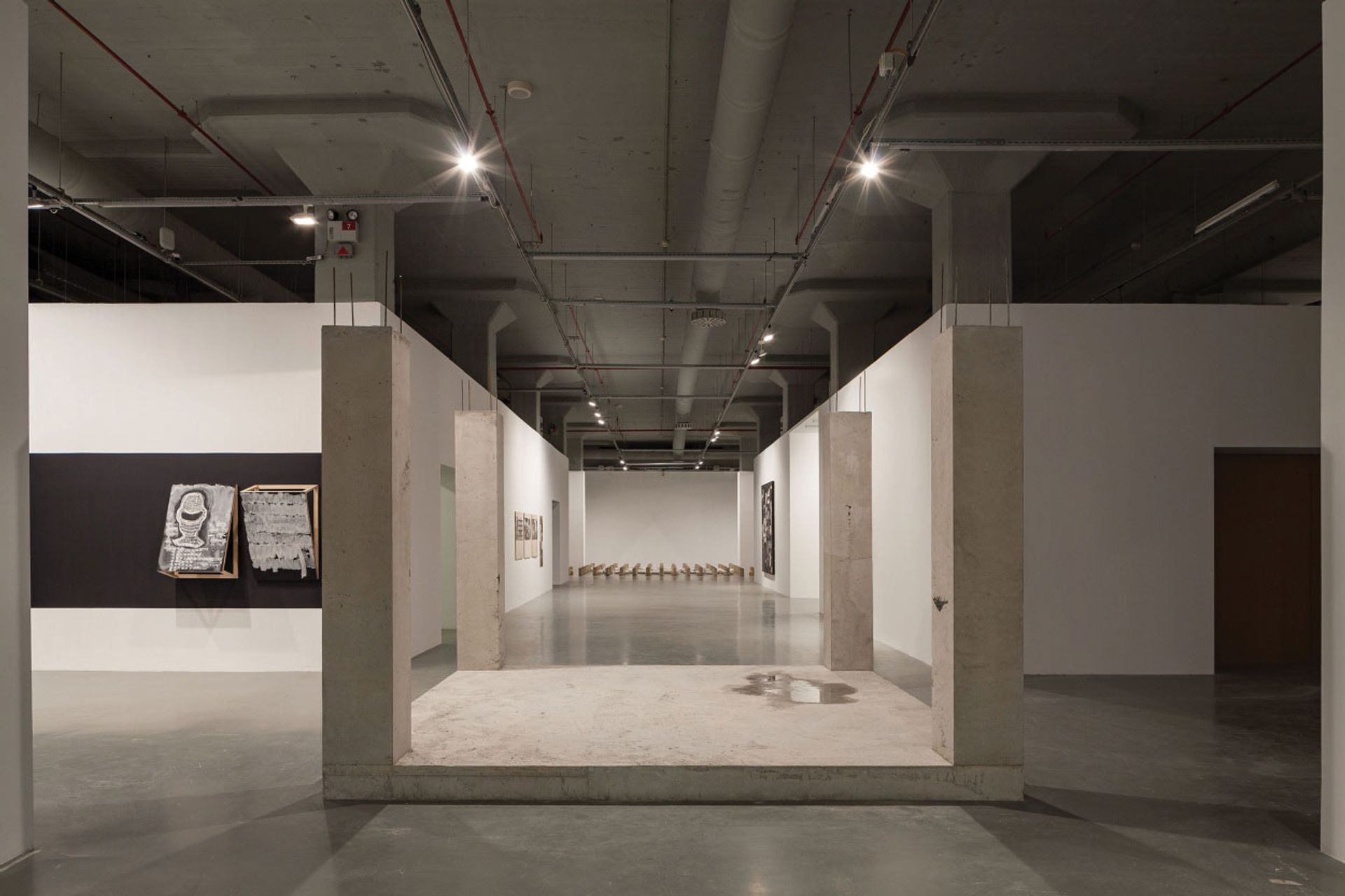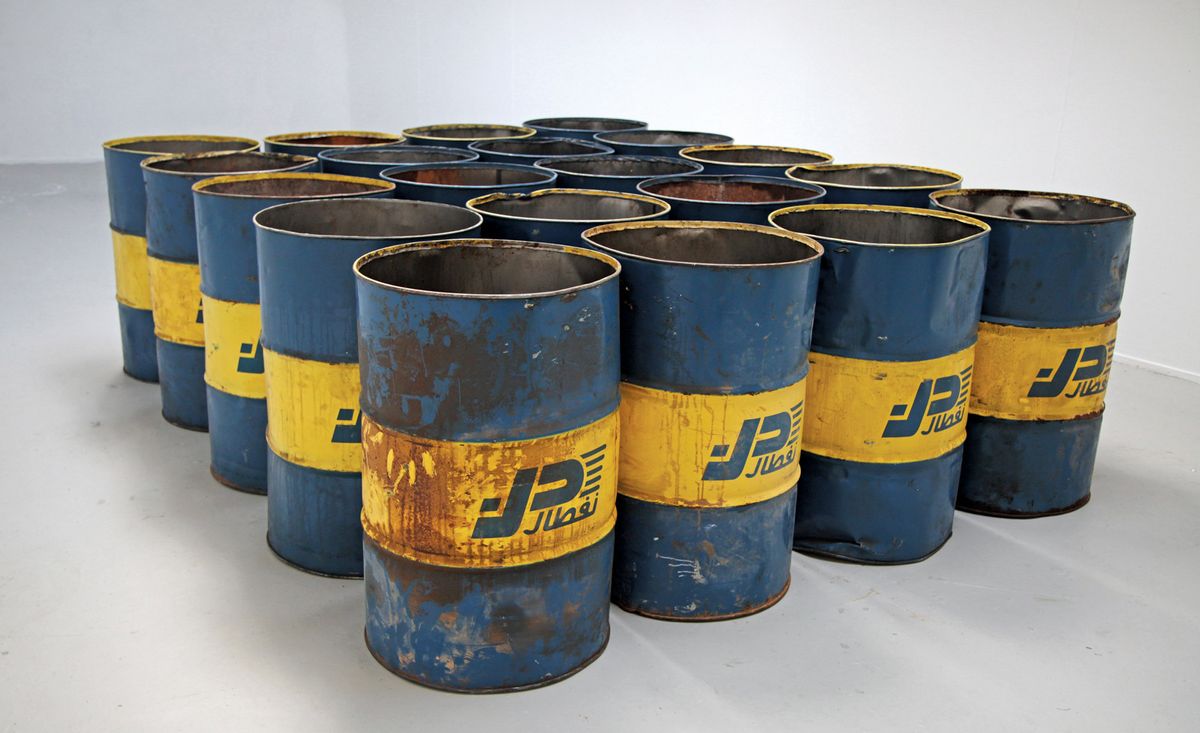Lydia Ourahmane’s deft, deeply personal approach to exploring major geopolitical issues of our time has prompted international interest in her work. Following on from her appearance in the Istanbul Biennial last year, she has been busy in the early months of 2018, opening a solo show at London’s Chisenhale Gallery, and preparing for the New Museum Triennial in New York and a group exhibition at the Ghebaly Gallery in Los Angeles.
Her work is informed by the events in her own life and those of her family, with a strong undercurrent of storytelling allied to a conceptual approach, leading to works in installation, sound, photography, film and text. Born in 1992 in Saïda, Algeria, to an Algerian father and Malaysian mother, Ourahmane now lives between London and Oran, in the north-west of the country. She spent her early years in Algeria and came to live in the UK in 2001; her parents had met in London. She remembers the experience of emigration as a “physically violent process, to be lifted out of a situation, and also a way of understanding how your body exists in a space”—themes that infuse her work today.
Ourahmane studied at Goldsmiths college in London, graduating in 2014, and has been showing her work internationally ever since. Her projects involve long and often complex periods of research. “I try as much as possible to be present and open to whatever can happen; I don’t have a plan a lot of the time,” she says. “I just see what I feel, and follow what feels right. And this is the way that I think about the production of art or how I make work: I am doing my research and it will just dip into this moment where I show something. It’s like debris that falls off and accumulates at certain points.”
This approach is exemplified by a new work in the Chisenhale show, Droit de Sang (Blood Right). The work features documents relating to her paternal grandfather, who was involved in the liberation of Algeria from French colonial rule, and avoided military conscription to the French army by removing all his teeth to be excused on medical grounds. Ironically, as Ourahmane’s work reveals, his documents are now being used by his descendants to claim French citizenship, prompting major ruptures in her family. This complex story of colonialism, political conviction, migration and belonging is typical of Ourahmane’s poetic exploration of history and the present, the personal and the political.

The artist Lydia Ourahmane
The Art Newspaper: At the core of your Chisenhale show is a sound piece that emerges from beneath a wooden floor. Tell me about that.
Lydia Ourahmane: I was doing all these sound tests with these bodyshaker things, which turn any surface into a speaker. I wanted it to be something that actually is more like a physical experience rather than just a sonic one, something that the audience could feel resonating throughout the space and throughout the body. I have been editing it in waves, so it will be a very spatial experience. The image I have been referencing while I’ve been editing is this image that I took from the outside of my house in Algeria. There’s a corner that often has a group of teenage boys hanging out on it, and I was working with a few of these guys during my time there. I was speaking to [a boy called] Amine, asking what they did on that corner. He said: “We just watch people going up and down the street and talk about them and look at cars that go past.” So, what I wanted to create in the sound work was an atmosphere that embodies that experience of waiting for something to happen. I have been thinking about landscapes that are key to projection.
You mean the projection of an idea?
Yes, or of a feeling. What happens in that space when someone’s waiting for something. And that is very key to this show. It goes back to a lot of my previous works, the idea of escape and departure. It’s something that I couldn’t even try to ignore, because every young person in Algeria talks about leaving all the time; everyone is in a state of waiting to go.
Your subjectivity is crucial, in that you left the country and are talking to or making reference to people who want to leave. How do you characterise your position?
I can’t ignore what my position is. There’s no way of hiding that; it is always inherent in me. And that has always been recognised by whoever I am working with. There have been so many occasions where people will ask me to help them leave, because they think that if you have another passport, a British passport, or if you live outside the country, then you have some sort of power to send someone an invitation, to get them a visa.
How does the group of people on the corner appear in the work?
When I first found out that I was doing this show, I was in Algeria researching and working on the Istanbul Biennial [in 2017]. And in that time, my two dogs were stolen from my house, while I was there. So that experience was the starting point for this show. And my investigating and trying to find my dogs was how I became introduced to these guys.
People will ask me to help them leave, because they think that if you have another passport, a British passport, then you have some sort of power
Like so much of your work, there is a complex backstory, in this case involving police, identifying possible suspects who might have stolen the dogs and visiting them, feeling intimidated yet trying to establish a relationship with them.
What I found so strange about it was that I couldn’t find a physical resolution. For me, the way that I would have seen this resolved was if the dogs had been found, but I guess what I found so interesting in this situation was that, with the people that I came into contact with and tried to forge a relationship with beyond the initial encounter, you can’t get away from the fact that the whole time they were suspicious of me, while I was suspicious of them. So it almost felt like a dance, the whole time we were together.
What are the sounds in the work?
The sounds in this piece are field recordings, mainly of events or periods of time which I, for some reason or another, had felt it necessary to record. There are compositions I have been working on with various friends and musicians; melodies feature in the piece as body to hold the spatial aspect of the work. There are also recordings of music and sounds collected during my time in Algeria. I recorded a Gnawa group; Gnawa is a style of music that is part of Sufi [culture]—a form of worship that features these hour-long trances. The main instrument is the guembri, which is like a guitar. They talked about the guembri having three souls because it is made from three living things: the strings are made from the intestine of a goat, the back is made of wood, and the skin is the neck of a camel. There is a recognition of these materials as living on in a present, spiritual sense.
Tell me about the work with gold teeth in the Chisenhale show.
It’s called In the Absence of Our Mothers, and it started three years ago when I was doing a lot of research about illegal immigration. In a renowned market in Oran called Medina Jedida there is a section where, so people say, they sell stolen goods. I met a guy who showed me this gold figaro chain, and it looked like an object that he wouldn’t have owned. So I asked him where he got it from. He said that it belonged to his mum and that she wanted him to sell it for her. And then when I asked him the price of it, he said the equivalent to €300, which I had found out was how much it cost for people to pay for a seat in a boat that was going to Spain. So in my head when this connection was made, I was thinking that this chain that he potentially stole from his mum is the means for his escape. I bought the chain and I exhibited it in my solo show in Dublin but it didn’t feel like that was the right format for it to exist.
So how did you develop the work from there?
Last summer when I was back in Algeria, my uncle told me about my grandfather, whom I never met; he died before I was born. He was in Oujda in Morocco and, at the time, Algeria and Morocco under French occupation were basically one country. Everyone had to do military service for two years but he was kept on for a further seven years because he was an amazing sniper; apparently he would never miss a shot. So they kept him on to train other soldiers and then, in 1945, during the Second World War, he was asked to go and fight. During the First World War, the French lost 1.4 million of their soldiers, so they started pulling from the Empire. He knew that if he left, he probably wouldn’t be able to return. He was trying to see how he could get out of the army and his friend told him that if you pull out all of your teeth, then you will be dismissed because you have to be physically fit and have your teeth. So, during his two-week holiday period in April, he pulled out every single one of his teeth on his own. He went back to the military and he was dismissed, obviously. And when I heard that story, I was thinking about the intent of doing something like that, which is irreversible; he had dentures for the rest of his life. I was thinking about that as a means of escape, and when I went back to this idea of this gold chain, the two ideas made sense to me in the form of the work which I am showing here; I have had the chain melted down into two gold teeth, one of which is implanted in my mouth and the other is exhibited in the space.
So have you had to extract one of your teeth, like your grandfather did back then?
No, I already had a hole. When I went for the initial procedure, the way that they implant a tooth is they drill a hole into your bone and then they put in this screw. You then have to go through a period of integration; the bone has to grow around the screw and accept it, so there’s a potential that your bone could reject the foreign object. And I thought that was so beautiful because the word “integration” is used so often in relation to immigration, but on social and economic terms—it almost dehumanises that process.
• Lydia Ourahmane: The You in Us, Chisenhale Gallery, London, until 25 March; The Pain of Others, Ghebaly Gallery, Los Angeles, until 3 March; New Museum Triennial: Songs for Sabotage, New Museum, New York, 13 February-27 May
LYDIA OURAHMANE: THREE KEY WORKS

Lydia Ourahmane: The Third Choir (2015) Frederik Gruyere
The Third Choir (2015)
The physical manifestation of this work consists of 20 empty oil barrels branded with the name of the Algerian oil company Naftal, from which an atmospheric, industrial soundtrack can be heard, relayed through mobile phones at the bottom of each barrel. But the backstory of their shipment from Algeria to Europe across the Mediterranean, and the 934 documents that Ourahmane gathered in the tortuous process of their export, are an important resonance. “It is the same oil that’s exported to Chevron, Total, BP, but it never leaves the country under Naftal,” she says. Young Algerians blame the oil industry for the country’s social and economic problems, prompting their desire for escape. “I wanted to use the barrels for a symbol,” Ourahmane says. “As they came under such an intensified bureaucratic procedure in their exportation, they became very human.”

All the way up to the Heavens and down to the depths of Hell (2017) The artist; Sahir Ugur Eren
All the way up to the Heavens and down to the depths of Hell (2017)
Created for last year’s Istanbul Biennial, this work relates to the effects of industrial waste in the town of Arzew, just outside Oran. “The government doesn’t care about who lives there, because the land is useless to it; it’s an industrial area.” At the beginning of her research, she spoke to people in this, her former hometown, who explained that “they knew they were being poisoned but there was no point trying to complain about it because nothing could change”, she says. A plaintive trumpet piece informed by military bugle melodies, written by Ourahmane with her trumpeter friend Adam Chatterton, “tries to invoke that sentiment”, Ourahmane says. “I thought it also acts as a cleansing.”

Corales (2016) Lydia Ourahmane
Fleeing Will Save Us (2017)
“Photography is such a huge part of my practice but I never really show the photographs,” Ourahmane says. This work is a rare exception. She has only recently begun to make Polaroids and in this case captured “two images of a cave area that is used as a departure point”, she says. “If you go to the caves, you will see fishing boats tucked into them, but this is an area that is known. They’re photographs of this place, which I was led to by word of mouth.” The images do not include portraits of those who seek to escape, however. “I don’t use people,” she says. Instead, most often, she uses objects “to signify or represent people. Because they drive everything that exists in all of my work.” The photographs were recently acquired by the British Museum in London.


